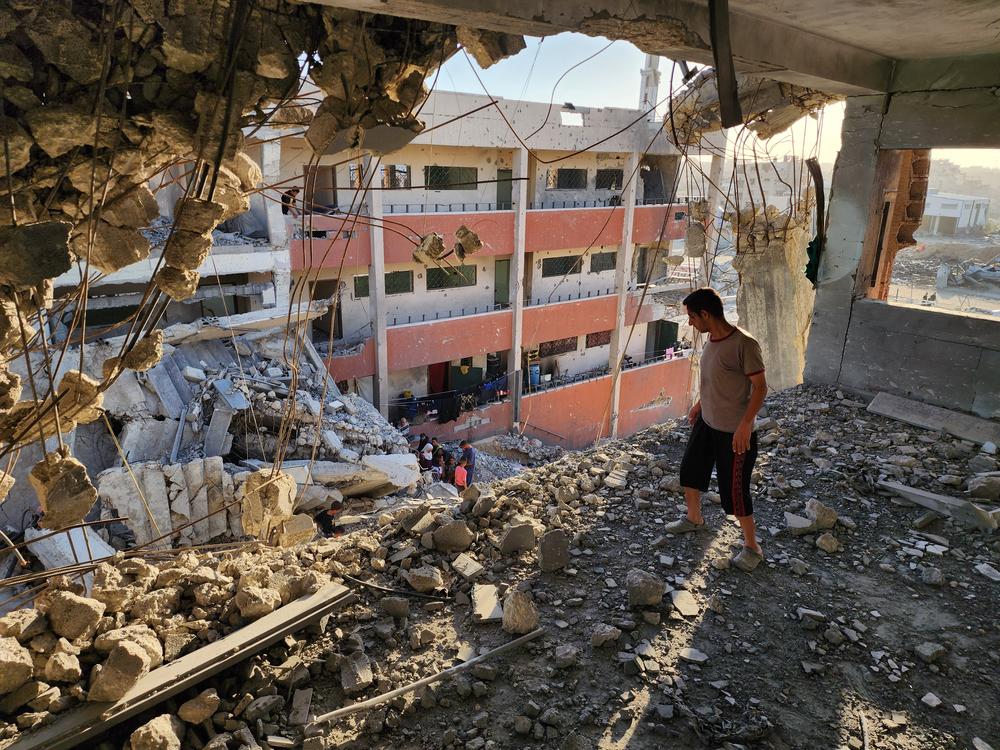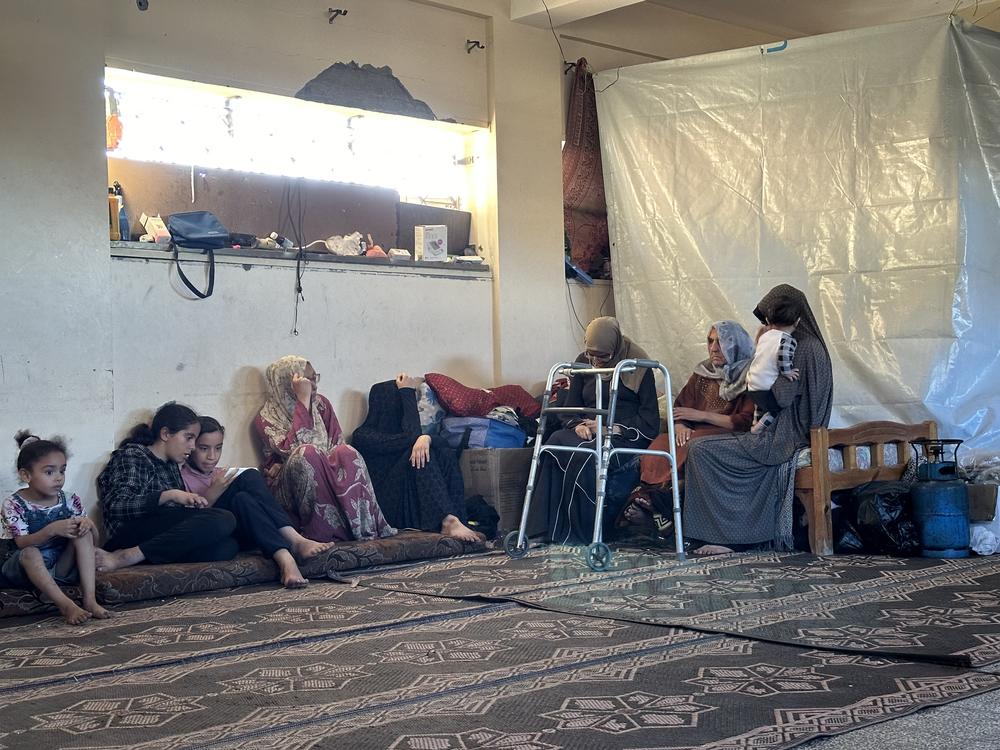Section Branding
Header Content
A family fled Rafah as the war closed in. Now they're living in a bombed-out school
Primary Content
KHAN YOUNIS, Gaza Strip – Mona Abu Issa is cooking canned corned beef in a big cast iron skillet balanced atop a grate. A few slices of onion and green pepper are mixed in — precious fresh vegetables. A wood fire burns underneath.
“There’s no gas, so we have to build a fire,” the 27-year-old explains.
This makeshift kitchen is outside, and wood smoke blackens a concrete brick wall nearby. It’s one of the only walls around that’s still standing.
Khan Younis was the epicenter of heavy fighting, Israeli airstrikes and shelling a few months ago. The city is now in ruins. Piles of rubble lie as far as the eye can see. Skeletons of former buildings jut out against the skyline.
One of these is a multistory school that Abu Issa, her two young children and her extended family — 20 people total — now call home. It’s mostly crumpled, but four classrooms are partially standing. Four different families live in each.
Abu Issa and her family came here from the southern city of Rafah in mid-May, nearly three weeks ago.
Earlier in the war, the Israeli military declared Rafah safe, and about a million Palestinian civilians fled there from the north. But in early May, Israel began a military offensive into Rafah, and has been pushing deeper into the city. Now, much of the city is under evacuation orders — and even those not under such orders haven’t been spared violence.
Following an Israeli airstrike on a camp of displaced people last month, Palestinians have been fleeing the city en masse. More than a million people have left, according to UNRWA, the United Nations agency that aids Palestinian refugees — but options on where to go are extremely limited.
Inside the classroom where Abu Issa now lives, children run around the open space. Sheets are draped from the ceiling in an effort to create privacy. A blackboard still hangs in front, and someone has written a Muslim prayer in chalk. Laundry is drying on string stretched across the classroom like a giant web.
“We knew about displacement, because we had housed families in Rafah,” Abu Issa says, explaining that her family had sheltered eight other families in their home at different times, all fleeing from the north.
They never thought that they, too, would be displaced. But then, a few weeks ago, the Israeli military dropped leaflets from the skies ordering civilians in their neighborhood to evacuate.
“I felt total panic,” Abu Issa remembers, saying that the displaced families they were sheltering had told them, “When the leaflets come, you must go.”
“They announced the decision in the morning. We had lunch at home, and as soon as we had lunch, the bombing started,” her brother Ibrahim Abu Issa, 24, chimes in.
Ibrahim says the family only had time to grab some clothes and enough canned food to last about a month.
They originally fled to al-Mawasi, a sandy area outside Rafah declared a humanitarian zone by the Israeli military. People have been setting up tents there, but the Abu Issa family didn’t have a tent. So they went further north to Khan Younis, a city they knew was destroyed, but was the only other place they could think to go.
It was a family they had sheltered who gave them the tip about the classroom that has been their makeshift home ever since. They feel lucky they found it.
“When we came here, everything was wrecked,” Ibrahim says. “So we cleaned and we mopped. We laid down some mats and organized things.”
They sorted through pieces of furniture and supplies, and made use of as much as they could. Ibrahim shows off a small toilet stall they made in a corner. One wall is a tall metal cabinet; the door is a chalkboard attached by its side.
Inside is a toilet the family bought for around $30, pooling what little savings they had. There isn’t running water in Khan Younis anymore — there’s barely water at all — so they chipped a hole in the wall behind the toilet so the waste can fall down below.
The toilet was important, Ibrahim says, because his disabled grandmother, Maryam, who is in her 80s, is with them.
She was a little girl back in 1948, when Israel was created and Palestinians were forced in the war to move from their land to places like Gaza. Her family walked there from Jaffa, outside Tel Aviv — a little over 40 miles.
“The [Israeli] military told us that Gaza was safe, so we settled here,” Maryam remembers.
Her family built their home in Rafah, and she has lived there ever since. But now, Maryam is displaced again.
“Where can people go? Where?” she asks.
Nowhere is safe, she says. There’s nowhere for people to go.


